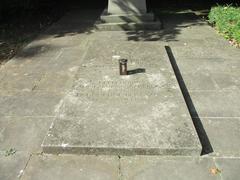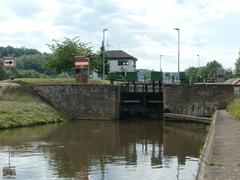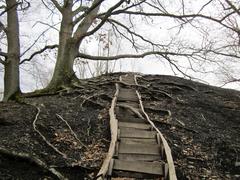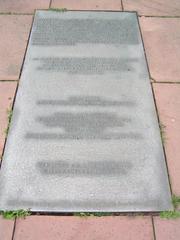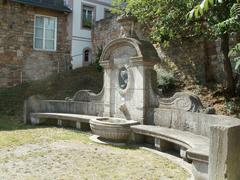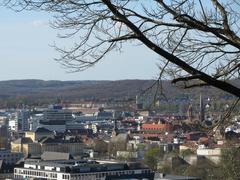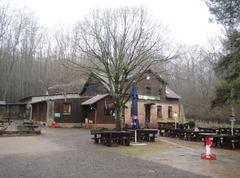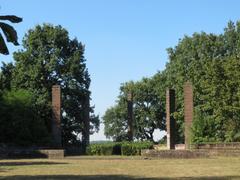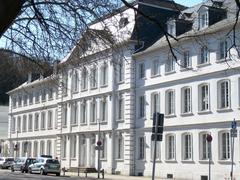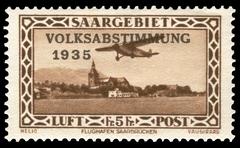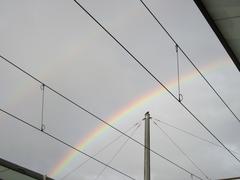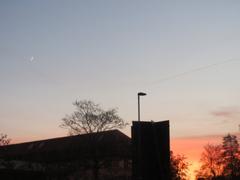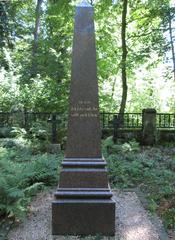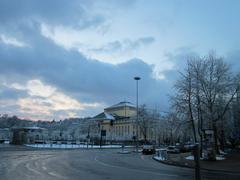Einsegnungshalle Saarbrücken: Visiting Hours, Tickets, and Historical Information
Date: 14/06/2025
Introduction
The Einsegnungshallen of Saarbrücken are significant landmarks that reflect the city’s deep-rooted traditions surrounding mourning, remembrance, and architectural evolution. Situated mainly within the Hauptfriedhof (Main Cemetery) and the Dudweiler Cemetery, these consecration or funeral halls are more than functional spaces—they are cultural and historical touchstones illustrating the city’s journey through time. This guide provides detailed insights into the history, architecture, visitor information, and practical tips for exploring the Einsegnungshallen in Saarbrücken, ensuring a meaningful and well-informed visit. (saarbruecken.de, marcokany.de, friedhoefe.saarbruecken.de)
Table of Contents
- Introduction
- History and Significance
- Architectural Highlights and Symbolism
- Visiting Information
- Cultural Significance
- Funeral Halls in German Context
- Visitor Experience & Heritage Tourism
- Guided Tours & Events
- Visitor Etiquette
- FAQs
- Conclusion
- Sources
History and Significance of the Einsegnungshallen
Early Origins and Urban Context
The rise of Einsegnungshallen in Saarbrücken mirrors wider European trends in urbanization and secularization during the 19th and 20th centuries. As city populations grew, the need for dedicated, dignified funeral spaces became apparent, prompting the establishment of several such halls across Saarbrücken’s cemeteries. (saarbruecken.de)
Dudweiler Cemetery and the Alte Einsegnungshalle
The “Alte Einsegnungshalle” at Dudweiler Cemetery is among Saarbrücken’s oldest, spanning over 10 hectares. Its historic entrance and funeral hall have been under monument protection since 1987, emphasizing their value. After restoration in 2002, the hall now includes a columbarium and a sepulchral museum. The site also features the gravestone of local writer Lisbeth Dill. (friedhoefe.saarbruecken.de)
Hauptfriedhof: Neue Einsegnungshalle
Designed by Peter Paul Seeberger and constructed between 1963 and 1965, the Neue Einsegnungshalle at the Hauptfriedhof is a hallmark of post-war modernist architecture. Recognized for its exposed concrete structure, minimalist “shoebox” form, and striking bell tower, it is lauded for its spatial purity and serene interior, featuring a wooden ceiling and distinctive triangular windows. (robbylorenz.de, saarbruecker-zeitung.de)
Other Notable Einsegnungshallen
Additional funeral halls in districts like St. Arnual, though less architecturally prominent, serve important communal roles and contribute to Saarbrücken’s layered funerary heritage. (mapcarta.com)
Architectural Highlights and Symbolism
- Alte Einsegnungshalle: Features 19th-century historicist design, reflecting the era’s funerary arts.
- Neue Einsegnungshalle: Embodies modernist ideals with its clean lines, exposed materials, and abundant natural light. The interplay of light and shadow, along with abstract reliefs and subtle religious symbolism, fosters an atmosphere of reflection and dignity. (marcokany.de)
Visiting Information
Opening Hours & Admission
Cemetery Grounds:
- November–February: 8:00–17:00
- March: 8:00–18:00
- April: 7:00–19:00
- May–August: 7:00–20:00
- September: 7:00–19:00
- October: 8:00–18:00
Halls:
Primarily open during scheduled ceremonies or events. Entry is free; no tickets are required for the cemetery or halls, though special events may require advance booking.
Accessibility
Both the Alte and Neue Einsegnungshalle are wheelchair accessible, with paved paths and ramps, and seating for up to 90 people. Restrooms and water are available; special vehicle access can be arranged for those with mobility needs. (friedhoefe.saarbruecken.de)
Directions
- Dudweiler Cemetery: Bus lines 103 & 109 from city center; on-site parking available.
- Hauptfriedhof: Bus lines 101, 109, 110, 123, 126; stops at Metzer Straße or Habsterdick. Car access is regulated—permits are needed for elderly or mobility-impaired visitors, with limited entry hours.
Nearby Attractions & Travel Tips
Combine your visit with other Saarbrücken highlights such as the Baroque Ludwigskirche, Saarbrücken Castle, and the UNESCO-listed Völklingen Ironworks. Guided tours are occasionally available, especially during heritage days. (germany.travel)
- Best times: Weekday mornings or late afternoons for a quieter experience.
- Tips: Obtain a cemetery map, check signage (mainly in German), and consider a translation app.
Cultural Significance
The Einsegnungshallen are more than ceremonial spaces; they reflect Saarbrücken’s Franco-German heritage and function as venues for both religious and secular ceremonies. They serve as sites for collective mourning, public commemorations, concerts, and exhibitions, especially during cultural festivals. (Studying in Germany)
Funeral Halls in German Context
German funeral halls have evolved from traditional chapels to contemporary, multi-purpose spaces that support diverse rituals and populations. The shift towards modern, inclusive architecture is embodied by the Neue Einsegnungshalle, merging tradition with innovation and serving as an architectural model regionally and nationally. (Live In Germany)
Visitor Experience & Heritage Tourism
The Einsegnungshallen are integrated into Saarbrücken’s broader historical landscape, connecting visitors to sites such as Ludwigskirche and Saarlandmuseum. Participation in guided tours offers deeper insights into communal rituals, funerary art, and the city’s architectural evolution. (delveintoeurope.com)
Guided Tours & Events
Guided tours are available through Saarbrücken Tourist Information, with special access often granted during the annual “Tag des offenen Denkmals” and other cultural events. Advance booking is recommended. (tourismus.saarbruecken.de)
Visitor Etiquette
- Maintain a respectful, quiet atmosphere.
- Photography is permitted outside ceremonies; always seek permission for indoor or event photography.
- Modest attire is expected; pets are not allowed except service animals.
- Smoking, eating, and drinking are discouraged within halls and near graves.
Frequently Asked Questions (FAQ)
Q: Are the Einsegnungshallen open for casual visits?
A: The halls are generally accessible during ceremonies or by arrangement for tours or events.
Q: Is there an entry fee?
A: No, entry to the cemetery and halls is free. Some events may require tickets.
Q: How can I arrange a guided tour?
A: Contact Saarbrücken Tourist Information at Rathaus St. Johann for scheduling.
Q: Is the site wheelchair accessible?
A: Yes, most areas and both halls are accessible.
Q: Is photography allowed?
A: Yes, in outdoor areas and with permission indoors, except during ceremonies.
Contact Information
Cemetery Administration:
- Ulrike Mohr: +49 681 905-4322 | [email protected]
- Stefan Ruloff: +49 681 950-4351 | [email protected]
(friedhoefe.saarbruecken.de)
Tourist Information:
- Rathaus St. Johann: +49 681 95909-200 | [email protected]
(tourismus.saarbruecken.de)
Safety & Environmental Considerations
The Hauptfriedhof is tranquil and safe. Stick to marked paths, respect the flora and fauna, and dispose of litter responsibly, especially during inclement weather when surfaces may be slippery.
Visual Resources
Explore high-quality images and virtual maps of the Einsegnungshallen and Hauptfriedhof via the official website. (friedhoefe.saarbruecken.de)
Conclusion
The Einsegnungshallen of Saarbrücken offer a profound blend of history, architecture, and cultural significance. These halls are not only places of farewell but also enduring monuments that narrate Saarbrücken’s evolving approach to remembrance and community. For a meaningful visit, plan ahead using official resources, join a guided tour, and consider integrating your trip with other historical attractions. Digital tools such as the Audiala app can further enrich your experience.
For updates and more insights, refer to the Saarbrücken tourism website and official cemetery pages. (friedhoefe.saarbruecken.de, saarbruecker-zeitung.de)
Sources
- Saarbrücken City History
- Friedhöfe Saarbrücken – Dudweiler Cemetery
- Robby Lorenz – Hauptfriedhof Saarbrücken
- Saarbrücker Zeitung – Seeberger’s Einsegnungshalle
- Mapcarta – St. Arnual Cemetery
- Germany Travel – Saarbrücken
- Marco Kany Portfolio – Einsegnungshalle
- Studying in Germany – German Funeral Traditions
- Friedhöfe Saarbrücken – Hauptfriedhof
- Saarbrücken Tourism Information
- Delve into Europe – Things to Do in Saarbrücken
